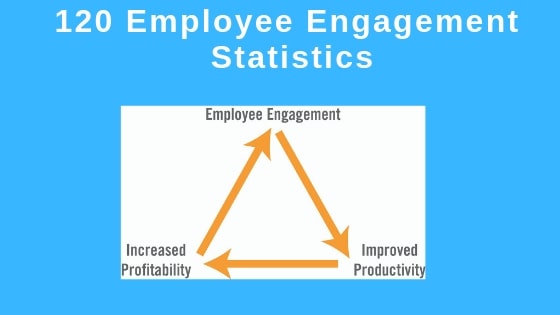If you are new to the business world, you will find the term ‘employee engagement’ popping up everywhere. So let’s understand what does the term actually means:
Simply put, ‘Employee Engagement is an emotional connection that an employee has towards his or her organization, which influences his or her behavior in the workplace activities. Hence, more employees engaged leads to greater effort, increased innovation. productivity and better results.
Why is employee engagement important?
Employee engagement goes way beyond activities or events in the organization. Employee engagement is the driving force behind employee performance. Employees who are engaged understand the purpose of the organization, and how and where they fit in. It not only leads to better decision-making but also helps the organization to surpass its competition. Engagement plays a key role when it comes to the innovation and growth of a company.
Five benefits of effective employee engagement in the workplace:
Higher level of productivity.
A boost to the work environment.
Better retention rate of the top performer.
Increased sense of well-being and health.
Drop in the healthcare costs.
Employee engagement is crucial for every organization. But it is difficult to measure, improve and benchmark as every organization is different. It is therefore essential to stay up to date with the current employee engagement data and trends for improving employee engagement at your organization.
So, here’s a quick summary of what the employee engagement statistics below tell us:
- There is a large number of employees that are not engaged at work, with remote workers being the least engaged,
- Employee engagement is not a priority for every organization,
- To have disengaged employees in an organization can turn out to be extremely costly, in regards to profit or revenue generation and competitiveness,
- The culture of an organization plays a huge role in keeping employees engagement.
- An Organization that promotes employee engagement not only encourages internal activities and productivity but also positively impact their overall brand exposure.
- The statistics show that the employees who are engaged are more productive and are more likely to stick to the organization, even in the long-run.
You can make use of the statistics to explore areas of concern in your organization, where engagement can enhance and develop your business.
Here are 120 employee engagement statistics that you should surely look into:
120 Employee Engagement Statistics
1. 36% of the organizations see employee engagement as a top challenge- Globoforce
2. 78% of businesses have a recorded employee engagement strategy and about 50% measure the success of it- Maritz Motivation
3. Companies with high employee engagement outshine those with low employee engagement by 202%- Business2Community
4. 37% of employees are engaged, 56% of employees are not engaged, and 73% of the actively disengaged employees are looking for new job opportunities or are open to it- Gallup
5. The employees who have disengaged cost businesses up to $450 and 550 billion dollars annually- The Engagement Institute
6. Financial service and heavy manufacturing service industries are the ones with the highest employee engagement- Modern Survey
7. Light manufacturing, hospitality, and the government industries are with the most disengaged employees- Modern Survey
8. The best-known methods to actively engage and drive employee engagement are: drafting employee engagement surveys (55%) and building employee resource groups (20%)- CultureIQ
9. The strongest engagement driver believes in senior leadership, with growth and development placed second- Modern Survey
10. According to 53% of the HR professionals, employee engagement rises with the improvement in onboarding- SilkRoad
11. The origin of workplace stress: Heavy workload and deadlines (33%), achieving balance in work-place (22%), impractical expectations of managers (22%) and conflict between coworkers (15%)- Accountemps
12. According to 92% of the employees, having the technology to do their job efficiently impacts work satisfaction- Ultimate Software
13. 80% of employees feel more engaged at the workplace when their work is consistent with the values and mission of the company- IBM
14. Employees who utilize their abilities, strengths and skills every day are 15% less likely to leave their job, 8% more productive, and six times more likely to be engaged at their workplace- Gallup
15. 83% of the employees who have opportunities to take on new challenges within the company are more likely to stick with an organization- ReportLinker
16. 70% of employees who are given the authority to take action when an opportunity or a problem arises at the workplace, consider this as an important element of engagement- SHRM
17. 82% of the employees say that they will be more loyal to their employers if they have flexible work opportunity- Flexjobs
18. An employee whose voice is heard at the workplace are 4.6 times more likely to give their best performance- Salesforce
19. 45% of the employees say that they would feel more engaged with the workplace if their employer helped them to learn more about the impact of deductions and taxes- Kronos
20. According to 92% of employees, a display of empathy is important for employee retention- Businessolver
21. According to 70% of the employees, motivation and morale can boost massively if senior leaders said thank you more- Reward Gateway
22. 85% of employees say that they will stick longer with the company if their employer shows a higher level of social responsibility- Ultimate Software
23. The teams that are highly engaged in an organization result in 21% more profitability- Gallup
24. Active employee engagement programs in an organization can result in increased profits up to $2,400 per employee annually- Workplace Research Foundation

25. Organizations with engaged employees see a 26% increase in revenue and 233% greater customer loyalty- Aberdeen
26. Only 15% of the employees worldwide are engaged in their jobs- Gallup
27. About 59% of employees say that they have been working with their current employer for more than three years and 22% of the older employees (from age 30-37) have been with their current employer for more than seven years- Udemy
28. According to 42% of employees, development and learning is the most important factor when deciding where to work, and health insurance (48%) is the second most important- Udemy
29. If organizations offer career training and development, then 86% of the millennials will stick with their current employer and not leave their job- Bridge
30. If a job has no growth opportunity and direction for development, then 67% of the millennials will leave their position- Bridge
31. Amongst 3.3 billion adults in the world, only 7% report having a great job- Gallup
32. 64% of the workers are uncomfortable negotiating a higher salary with the employer at their new job- Ajilon
33. Female employees are 36% more likely to leave their current employer because of a bad manager than male employees (Female-34% Male-25%)- Ajilon
34. Almost half of the employees say that they quit a job because of a bad manager, out of which 56% think that managers are promoted ahead of time, and 60% think that managers need intensive training- Udemy
35. Men are 18% more likely to leave their current position for being underpaid compared to women (Men- 39% and Women- 33%)- Ajilon
36. 13.5% of the employees agree that the culture of the organization pushes them to accept another job opportunity- Ajilon
37. 44% of the employees leave their job for another job that pays better- Robert Half
38. 12% of employees say that they would leave their job if they don’t feel appreciated- Robert Half
39. 83% of the HR managers say someone quitting their position can really impact the future of the organization- Robert Half
40. 58% of managers extend their counteroffers to employees who are planning to quit their job. On average, these employees leave their position in less than two years- Robert Half
41. Out of 5 billion people in this world, only 1.4 billion or 28% have a “good” job, and only 16% of those employees are engaged- Gallup
42. 25% of the millennials have worked for five different organizations- O.C. Tanner
43. Out of the millennials who were employed at 5 or more organizations, 31% said that their company didn’t set goals, 34% did not trust their manager and 48% said that their organization only thought about making profits- O.C. Tanner
44. 39% of the employees would work harder if they are happy in their current position or workplace- One4all
45. 60% of workers say they have left jobs or are considering leaving their job because they do not like senior management, and 58% say that they would leave their current position because of office politics- Randstad
46. 58% of the employees say they would start a job with a lower salary if they got to work for a great and renowned employer- Randstad
47. Only 12% of businesses are happy with the current level of employee engagement- CBI
48. 69% of full-time employees face distraction at their workplace- Udemy
49. 60% of the workers say that meetings cause a distraction- Udemy

50. According to 65% of employees, they would be more productive if they get to work at home rather than in an office- FlexJob
51. 75% of the employees say that they get to experience higher productivity at home due to fewer distractions, no interruptions from co-workers (74%), and no office politics (65%)- FlexJob
52. Employees said that they prefer work-life balance more than salary when considering a job opportunity- FlexJob
53. 77% of employees said that they are more likely to accept a job opportunity if they are allowed to telecommute- Robert Half
54. 86% of workers between the age of 18 to 34, and 65% of the employers above the age of 55, said that they would sign a contract as soon as possible with remote work choices- Robert Half
55. 41% of workers said that they would only work for an employer if they offer agile employment opportunities- Spherion
56. 40% of employees reported that remote/flexible work could reduce distractions at the workplace, and 52% say that will be more productive if they work remotely- Udemy
57. 77% of the workers said that they could be more productive if they work away from home- Upwork
58. 55% of employers feel that stronger engagement can improve their ability to carry out succession planning, recruit and retain employees- CBI
59. 44% of businesses believe that better employee engagement can lead to better retention, while 36% of them think that it would have a positive impact on recruitment- CBI
60. 47% of businesses think that the current freedom in pension (401k) will make the employees more engaged- CBI
61. 42% of the businesses say that providing pension has a positive effect in retaining employees- CBI
62. A third of the job seekers left their job within 3 months; 43% of them said that their everyday role wasn’t something that they expected, 34% said that they faced an incident or a bad experience, 32% mentioned the culture of the company, 11% said that they signed up for a new job and later changed their minds- Jobvite
63. 32% of workers would take a 10% salary cut for a job they’re passionate about or interested in- Jobvite
64. The top reasons for quitting a job: pay (44%), limited career opportunity (43%), lack of challenges at work (30%), work and life balance (28%) and absence of recognition (27%)- Randstad
65. 11% of employees rejected a new job opportunity due to the absence of work-life balance opportunities, while about 75% of employees carefully make arrangements for the childcare before taking a new job or promotion- Working Families and Bright Horizons
66. More than 60% of workers would take up a job with lower pay for better benefits- Zenefits
67. More than 50% of workers report that they left their previous position after hearing about better benefits somewhere else- Randstad
68. 78% of employees are likely to stick with an organization due to the benefits they offer- WTW
69. 80% of workers said that the benefits they receive are good, also strongly identified with the company’s vision, in contrast to 40% of the ones who don’t- Thomsons Online Benefits
70. 81% of workers who can easily receive benefits said that they are loyal towards their employers and 79% say that they feel proud to work for the company- Thomsons Online Benefits
71. 77% of workers who understand the benefits being offered to them, said that they see themselves working for the organization even in the future- Thomsons Online Benefits
72. 64% of millennials believe that benefits are extremely important and display employer loyalty- Qualtrics
73. To get better benefits, 50% of the adults would leave their current position- Yoh
74. 42% of adults said they would quit for a more flexible job option- Yoh

75. 89% of employers said a flexible job is essential to attract staff and retain talent- Hays
76. 33% of employees said flexible working options are crucial for them to stick with their current employer- Hays
77. About 70% of millennials say that they have considered quitting a job for another more flexible job opportunity, but only 50% of the older employees have felt the same- FlexJobs
78. 80% of millennials feel that they would be more devoted towards a company that offers flexible options, whereas only 70% of the older employees feel the same way- FlexJobs
79. Around 80% of the millennials think about how a position will impact their work and life balance, and only 62% of older workers agreed to that- Flexjobs
80. Amongst older and younger employees, less than 10% feel that they produce quality work in the office, more than 60% reported that their productivity would increase if they telecommuted, and around 41% would not exchange vacation time or salary for telecommuting- Flexjobs
81. 44% of the employees reported that they would quit their present job for one that pays more salary- OfficeTeam
82. The reasons employees would quit their present job: they want to work for an organization that has a bigger mission and stronger purpose (12%), they feel unappreciated by their current employer (12%), they are bored or are unchallenged (12%), the commute is long (7%), they do not fit into the work culture (7%) or their boss is bad (6%)- OfficeTeam
83. Around one-third of adults would quit their job for a better position, a good company culture and a short commute- Yoh
84. According to 80% of employees, health insurance is important when deciding whether to stick with a job or not- EBRI
85. 15% of adults report that they would not leave their present job for any reason- Yoh
86. 47% of employees who have a higher education say that limited career options could make them leave their current position for a better opportunity- Randstad
87. 29% of employees plan to look for a new job in the next 12 months- Accountemps
88. Almost 24% of Generation X feel that their desire for being financially stable inspires them to stick to a job- Purchasing Power
89. 54% of underemployed workers actively looking for a job opportunity that pays better and is full-time- Snag
90. Around 4.5 million or 14% of employees are most likely to move to a new job- Robert Half
91. About 33% of professionals chose ‘I am bored and need a new challenge,’ as their inspiration to change a job and move on to another one- Korn Ferry
92. Organizations with better learning and work culture that appreciates employee engagement have 30-35% higher retention rates than those who do not- Robert Half
93. 83% of the employees who participate in a mentoring program agreed that the experience that they gather positively impact their desire to keep working for the company- River
94. 70% of employers believe that employees’ inclination towards “purpose” is affecting the ability of HR to recruit and retain top performers (69%), and around 65% said it is changing the traditional approach towards talent hiring and development, incorporating the compensation packages- Covestro
95. 68% of employees feel that employee engagement will improve in the workplace and workers will perform at a higher level if they had challenging opportunities like working on purpose projects inside or outside the organization- Covestro
96. 62% of employers see (employees engaging in short-term consulting projects that help the causes of non-profit organizations) as a way to lure top performers, increase employee engagement (70%), and build future leaders at their organizations (80%)- Covestro
97. 93% of non-profit workers are engaged at work; this rate is triple to the national average- Work for Good
98. 85% of workers who switched from profit to non-profit organizations reported that they plan on working for the non-profit organization- Work for Good
99. 75% of employers said that in the next ten years, in order to hire and retain employees, only providing compensation will not be sufficient- Covestro

100. 60% of organizations provide wellness programs to attract and retain workers, where only 14% of the organizations do not have any health culture or programs- Optum
101. 56% of Americans reported that their health plan is the main reason for them staying at their current job- America’s Health Insurance
102. 72% of employees did not accept the reason for why they didn’t get a raise, and 71% who got a reason reported that they started looking for a new job opportunity within the next six months- PayScale
103. Of the employees that got a reason as to why they did not receive a raise in their salary, only 25% believed it. Of the ones who did not believe the reason or didn’t receive a raise, 70% reported that they plan on seeking a new job opportunity within the next six months- PayScale
104. For 67% of employees who are seeking a job, money is the number one motivator- Glassdoor
105. 45% of hiring managers reported that salary is the biggest reason for workers to change jobs- Glassdoor
106. 7% of baby boomers and 59% of Generation Z will have to work for an employer for about 1 to 4 years before turning it into long-term employment- Sharefile
107. 12% of baby boomers and 34% of Generation Z, reported that the best way to get where they want to be is by moving from one company to the other- Sharefile
108. 63% of workers do not consider employment that offers less than 15 paid vacation/off days- Randstad
109. About 20% of those aged between 24-35 years reported that reputation for inclusion, diversity, ethical behavior, and workplace wellbeing are the most important factors while selecting an employer- Deloitte
110. 57% of employees feel that if their employer supported their mental wellbeing, they would be more productive, more loyal, and take fewer off days- Health Shield
111. According to Generation Z and Millennials, employers that have senior management teams and a diverse workforce makes them stay for five years or more- Deloitte
112. Among Generation Z and Millennials who reported they would stay with their employer for almost five years, 55% noted more flexibility in the workplace as compared to 3 years ago was an important factor- Deloitte
113. If Generation X is offered financial programs at their workplace, then 89% of them would be a part of it- Purchasing Power
114. Around two-thirds of baby boomers feel that younger employees are not as loyal and about 60% think that younger employees are more entitled- CompTIA
115. 47% of HR professionals said that employee turnover and retention is their biggest challenge- Globoforce
116. In business leadership positions, turnover rates are higher for women(31%) as compared to men (24.1%)- The Network of Executive Women
117. The attrition rates worldwide in other sectors ranges from 8% to 10% per year- The Network of Executive Women
118. 31% of retail workers reported that training makes them feel more engaged- Axonify
119. 63% of workers think that managers are the ones most responsible for sharing results based on engagement with teams- Quantum Workplace
120. 60% of workers reported that managers are most accountable for executing employee engagement strategies- Quantum Workplace
With a proper mindset and the right tools, employee engagement tracking can be a useful tool for every organization.

